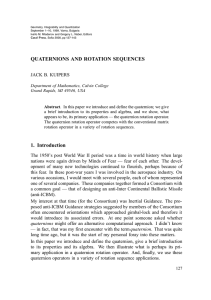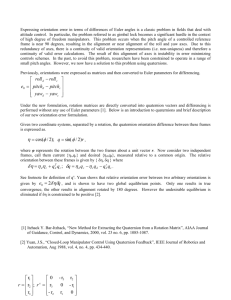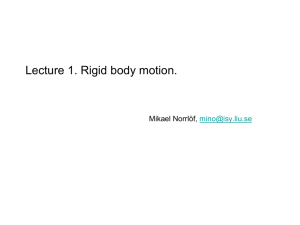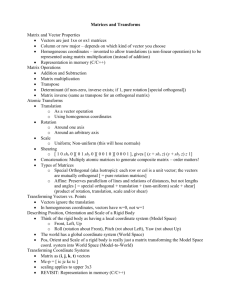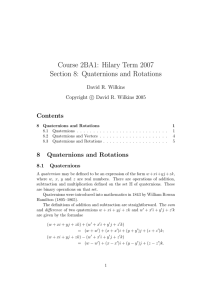Quaternions
advertisement
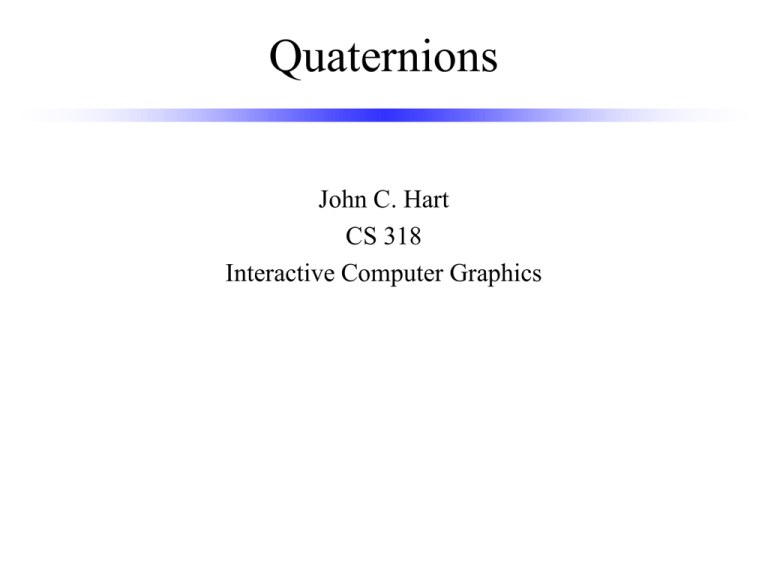
Quaternions John C. Hart CS 318 Interactive Computer Graphics Rigid Body Dynamics • Rigid bodies – Inflexible – Center of gravity – Location in space – Orientation in space • Rigid body dynamics – Force applied to object relative to center of gravity – Rotation in space about center of gravity • Orientation of a rigid body is a rotation from a fixed canonical coordinate frame • Representing orientation = representing rotation Euler Angles • Airplane orientation – Roll • rotation about x • Turn wheel – Pitch • rotation about y • Push/pull wheel – Yaw • rotation about z • Rudder (foot pedals) • Airplane orientation – Rx(roll) Ry(pitch) Rz(yaw) z y x Local v. Global • Roll 90 followed by pitch 90 • Which direction is plane heading? – In the y direction? – Or in the z direction? • Depends on whether axes are local or global • Airplane axes are local – heading, left, up • Need an orientation to represent airplane coordinate system • Orientation needs to be global z y x up left heading Gimbal Lock • Airplane orientation – Rx(roll) Ry(pitch) Rz(yaw) • When plane pointing up (pitch = 90), yaw is meaningless, roll direction becomes undefined • Two axes have collapsed onto each other z y x Space of Orientations • Any rotation Rx Ry Rz can be specified by a single rotation by some angle about some line through the origin • Proof: Rx, Ry and Rz are special unitary – Columns (and rows) orthogonal – Columns (and rows) unit length – Product also special unitary – Thus product is a rotation • Represent orientation by rotation axis (unit vector, line through origin) and rotation angle (scalar) z v y x Orientation Ball • Vector v represents orientation ||v|| p • Decompose v = q u – q = angle of rotation: 0 q p – u = axis of rotation: ||u|| = 1 • Angles greater than p represented by –u • All orientations represented by a point in the orientation ball v 0 p ArcBall • How to rotate something on the screen? • Assume canvas (window) coordinates • Click one point (x0,y0) • Drag to point (x1,y1) • Consider sphere over screen • Then z0 = sqrt(1 – x02 – y02) and z1 = sqrt(1 – x1 – y1) give points on sphere v0 and v1. • Then rotation axis is u = v0 v1 unitized • Angle is q = sin-1 ||v0 v1|| Quaternions • Quaternions are 4-D numbers q = a + bi + cj + dk • With one real axis • And three imaginary axes: i,j,k • Imaginary multiplication rules ij = k, jk = i, ki = j ji = -k, kj = -i, ik = -j Hamilton Math Inst., Trinity College Quaternion Multiplication (a1 + b1i + c1j + d1k) (a2 + b2i + c2j + d2k) = a1a2 - b1b2 - c1c2 - d1d2 + (a1b2 + b1a2 + c1d2 - d1c2) i + (a1c2 + c1a2 + d1b2 - b1d2) j + (a1d2 + d1a2 + b1c2 - c1b2) k • Scalar, vector pair: q = (a,v), where v = (b,c,d) = bi + cj + dk • Multiplication combines dot and cross products q1 q2 = (a1,v1) (a2,v2) = (a1a2 – v1v2, a1v2 + a2v1 + v1v2) Unit Quaternions • Length: |q|2 = a2 + b2 + c2 + d2 • Let q = cos(q/2) + sin(q/2) u be a unit quaternion: |q| = |u| = 1. • Let point p = (x,y,z) = x i + y j + z k • Then the product q p q-1 rotates the point p about axis u by angle q • Inverse of a unit quaternion is its conugate (negate the imaginary part) q-1 = (cos(q/2) + sin(q/2) u)-1 = cos(-q/2) + sin(-q/2) u = cos(q/2) – sin(q/2) u • Composition of rotations q12 = q1 q2 q2 q1 q q q cos u sin 2 2 q u p q p q-1 Quaternion to Matrix The unit quaternion q=a+bi+cj+dk corresponds to the rotation matrix 𝑎2 + 𝑏 2 − 𝑐 2 − 𝑑 2 2𝑏𝑐 + 2𝑎𝑑 2𝑏𝑑 − 2𝑎𝑐 2𝑏𝑐 − 2𝑎𝑑 𝑎2 − 𝑏 2 + 𝑐 2 − 𝑑 2 2𝑐𝑑 + 2𝑎𝑏 2𝑏𝑑 + 2𝑎𝑐 2𝑐𝑑 − 2𝑎𝑏 𝑎2 − 𝑏2 − 𝑐 2 + 𝑑2 1 y Example • Rotate the point (1,0,0) about the axis (0,.707,.707) by 90 degrees z p = 0 + 1i + 0j + 0k =i q = cos 45 + 0i + (sin 45) .707 j + (sin 45) .707 k = .707 + .5 j + .5 k q p q-1 x = (.707 + .5j + .5k)(i)(.707 - .5j - .5k) = (.707i + .5(-k) + .5j)(.707 - .5j - .5k) = (.5i - .354k + .354j) + (-.354k - .25i - .25) + (.354j + .25 - .25i) = 0 + (.5 - .25 - .25)i + (.354 + .354)j + (-.354 - .354)k = .707j - .707k Exponential Map • Recall complex numbers eiq = cos q + i sin q • Quaternion a + bi + cj + dk can be written like a complex number a + bu where b = ||(b,c,d)|| and u is a unit pure quaternion u = (bi + cj + dk)/||(b,c,d)|| • Exponential map for quaternions euq = cos q + u sin q • Quaternion that rotates by q about u is q = eq/2 u = cos q/2 + sin q/2 u SLERP • Interpolating orientations requires a “straight line” between unit quaternion orientations on the 3-sphere • The base orientation consisting of a zero degree rotation is represented by the unit quaternion 1 + 0i + 0j + 0k • We can interpolate from the base orientation to a given orientation (q,u) as q(t) = costq/2 + u sintq/2 = et(q/2)u • To interpolate from q1 to q2We can interpolate from the base q(t) = q1(q1-1q2)t Derivation q2 u2 u1 • To interpolate from q1 to q2 we can interpolate from the base q(t) = q1(q1-1q2)t = exp((q1/2) u1) (exp((-q1/2) u1) exp((q2/2) u2) )t = exp((q1/2) u1 + t((-q1/2) u1) + t((q2/2) u2)) = exp((1-t)(q1/2) u1 + t((q2/2) u2)) • Rotation interpolation is the exponential map of a linear interpolation between points in the orientation ball q1 =e
